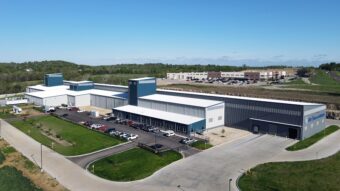As market conditions change over the years, so does property management.
Whether it’s increasing costs or differing work strategies due to changes, managers have to be on their toes at all times.
Factors influencing the increase in costs are usually those that are not easily controlled—utilities, taxes, unions, and insurance are the primary factors.
According to Clarice Gunther, general manager for CBRE at Atrium Corporate Center in Rolling Meadows, the energy management laws and building codes are continually changing, resulting in increased prices. Energy Star and LEED requirements are also increasing.
The changing nature of ownership structures also affect cost, whether it is rapid growth or acquisition of properties, this creates a lot of pressure.
Randel Waites, principal of property management at Avison Young, said the firm has seen fee compression and employee costs as larger investment vehicles have entered the market, acquiring large and geographically dispersed portfolios.
One example of this is IndCor Global Logistics Properties’ rapid growth after recently purchasing IIT’s $4.5 billion portfolio, and adding its 58 million square feet throughout 200 properties.
“If you’re servicing them, you can see the constraints that puts on doing the services,” he added.
Gunther said that over the years, tenants are putting more employees in the same amount of space, and the higher employee population drives everyday costs higher—janitorial supplies, cleaning, HVAC, filters.
But in order to keep costs manageable, Gunther said it’s critical to know your building and understand the age of your building to know what can and cannot be done. It’s also important to determine the building’s needs as opposed to what owners, engineers, management, vendors and tenants want and instead, make informed decisions.
“A building’s controllable costs can be kept manageable through bidding,” she said. “Most important part of the bid process is to make sure your specs are written correctly. The next step is aggressive negotiating.”
Additionally, property managers should perform ongoing budget reviews, and not just when budgets are due. Gunther suggests to look at your monthly variances and your quarterly reports to see your numbers. She added that many companies also create bids on a regional or national level.
“In the Chicago suburbs, we bid our snow removal on a regional basis and have received very aggressive pricing with great service,” Gunther said. “We also have national service agreements for a number of vendor services, such as elevators, HVAC, and trash removal.”
Waites said management companies need to find efficiencies and bundle services while working with the owners to share in some of the ‘boots on the ground’ costs.
Property management strategies differ between industry sectors—snow removal, lot repairs, and roof become significantly more important in their impact on industrial sector operations.
“Limited access to an office due to snow is an inconvenience, but at a distribution center, it can bring operations to a half,” he said.
When it comes to retaining current tenants, he believes it’s no less critical in industrial than in other sectors—you need to know the tenants, know the leases, contain costs, and make sure building is being maintained. He noted that it’s important to work with owners, and property managers should assist them on repurposing where applicable.
“It’s important to understand,” Waites said. “Knowing that will help them design or repurpose the facility to get those tenants. Retention is a combo of what their business goals are. If they want to be there, they can be there.”
Gunther agrees. She said it’s good to have ongoing communication and an open door policy.
“People think of industrial space as blue collar and old fashioned, but it’s been widely effected by the changing nature of business and technology,” Waites said.
E-commerce, for example, has changed the nature of many industrial properties. There’s more material handling equipment and automation as bulk storage shifts to piece-picking for distribution—this requires more infrastructure, higher clear heights, stronger roods, accommodating more people, requiring amenities and air conditioned space and more docks, unconventional dock heights and traffic management are examples.
Waites believes that property management should also play a role in working with owners and asset managers to assist in repurposing facilities. This is an increasing trend with 70 to 80 percent of stock over 10 and 12 years old.
“The costs can be significantly lower than new construction and we should be assisting our clients who are building spec or even build-to-suits to incorporate flexibility in the design,” he added. “Things are changing too rapidly to accommodate what used to be an expected 20 year use of a facility.”
An additional trend in property management is the shift to more sustainable, green practices in the buildings. Some methods include managers implementing all low cost and no cost options, asking their contractors and vendors what they can do to help with energy efficiencies, and analyzing and understanding the market conditions along with rebates and incentives.
“We’ve added a required sign-off to our standard service agreement where vendors acknowledge our building is LEED-EB Silver and Energy Star rated so their services, policies, and procedures must be performed to these standards,” Gunther said.
Waites sees this as a struggle. He said it’s harder to achieve in the industrial property management market because many facilities are net leases and the management company may have limited influence over operations in the facility.
“Where there are multi-tenant spaces and more services in a lease, we can influence costs by working through retro fits to LED interior lighting and parking lot LED lighting,” he explained.
When it comes to new construction or repurposing net-zero buildings, a rule of thumb is $3 per square foot savings in energy costs. This used to be a saying that interested institutions and foundations, but Waites said it is gaining ground commercially.
Those required include: solar energy panels, green roofs, natural daylight, high efficiency on water usage—low water landscaping, rainwater recapture, recycled content, sustainable wood (certified by FSC Forest Steward Councilor the SFI Sustainable Forestry Initiatives), and regional materials.
Gunther predicts that in the next couple of years a general trend will be smaller workstations, higher employee count, and advanced technology.
“Companies will continue to allow employees to work from home but will also mandate an office visit to review performance and results,” she added.
Gunther explained that property managers are going to have to learn to accommodate the higher populations while keeping costs competitive.
“I also believes that many companies will focus on LEED and Energy Star ratings as they provide an accepted and recognized industry standard,” she said.
While Waites sees continued strong institutional and foreign investment along with continued change in use and repurposing challenges, he also sees a shift to heavy reporting and analytics.
Simple tools like Excel that are used for accounting and planning will no longer provide an efficient solution. He believes that in order to optimize managing a large quantity of properties with hundreds and even thousands of tenants, property management companies will need more realistic forecasts; faster, more efficient planning and accounting, virtual tracking and management vacant/occupied spaces.
“It’s about addressing the competitive landscape in the industry versus internal operational problems,” he explained.



